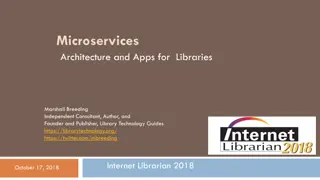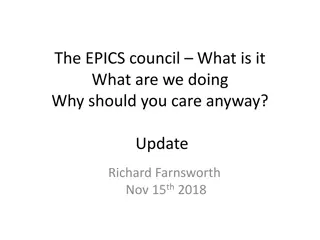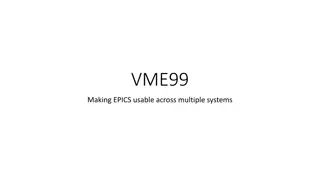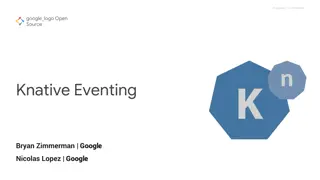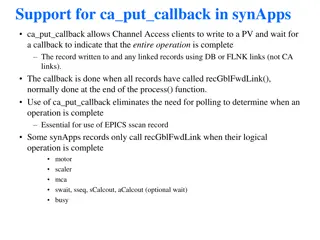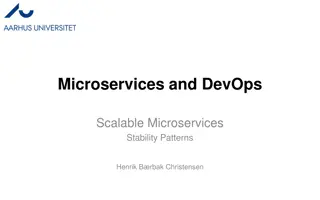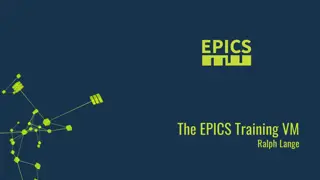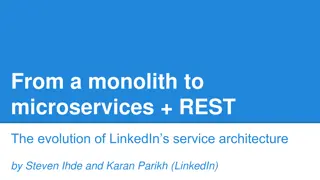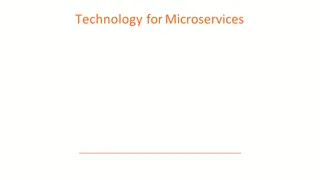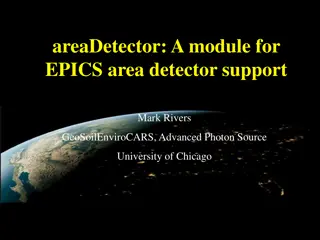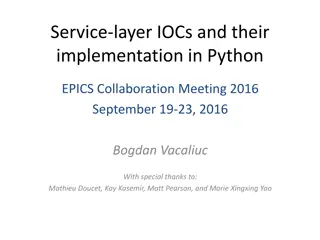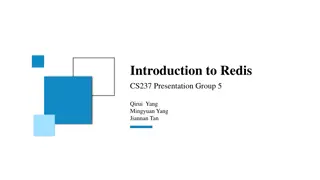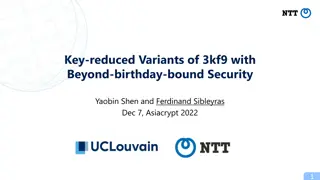Using EPICS V4 and Redis for Lightweight Microservices Architecture
EPICS V4 with Redis enables building small microservices efficiently, RPC service implementation simplicity, and Redis as an in-memory store for easy debugging and lightweight data management. SLAC utilizes this technology stack for creating small, SLAC-specific microservices with robustness and ease of deployment.
Download Presentation

Please find below an Image/Link to download the presentation.
The content on the website is provided AS IS for your information and personal use only. It may not be sold, licensed, or shared on other websites without obtaining consent from the author.If you encounter any issues during the download, it is possible that the publisher has removed the file from their server.
You are allowed to download the files provided on this website for personal or commercial use, subject to the condition that they are used lawfully. All files are the property of their respective owners.
The content on the website is provided AS IS for your information and personal use only. It may not be sold, licensed, or shared on other websites without obtaining consent from the author.
E N D
Presentation Transcript
Using EPICS V4 as a container for microservices Murali Shankar Greg White Matt Gibbs
Summary EPICS V4 with Redis is a lightweight, excellent way to build small microservices. 2
EPICS V4 RPC Specifically, talking about the RPCService interface in PVAccess. Has one method that looks like so PVStructure request(PVStructure args) Implement this interface Register the service To unpack the arguments in Java/C++, there is a bit of boilerplate In Python, Sinisa makes it extremely simple. Everything is a dict. 3
Redis In-memory key/value store Actually, the way I look at it, in-memory data structures external to your code. Very easy to debug your application. Backup/Replication/Cluster/Messaging Lightweight 4
Introduction At SLAC, we ve started to use EPICS V4 as a container technology for microservices. These are small services (a few classes/few 1000 lines of code) Often SLAC specific. Almost always in combination with Redis. V4 with Redis gives us A lightweight architecture. A standard communication mechanism Integrate multiple services using service based interfaces. Shows up in lists of PVS Standard help/documentation/management. Use cram for deployment. Very robust so far. 5
Arbo Replacement for the IRMIS crawler. Ernest adds some commands to every IOC startup. iocshCmd("dbl '' RTYP > ${IOC_DATA}/${IOC}/iocInfo/IOC.pvlist") ${IOC}/iocInfo/IOC.pvlist contains lines that look like so. SIOC:SYS0:ML01:SR_recentlyStr, "stringout SIOC:SYS0:ML01:SysReset, "sub SIOC:SYS0:ML01:CA001, "waveform" This is valuable information and can be used by multiple services. Arbo is a small service that watches these IOC.pvlist files and maintains in Redis. ${IOC} Current list of PV names for an IOC. ${IOC} Current list of waveform PV s for an IOC. 6
DS Starts with the list of PV names from Redis. Also adds in V4 channel names (from file exports). Adds in data exported from the model (into files) Devices Lines Elements Z-order Combines all of this to support a names and tags V4 service. Get me names that match a pattern Get me names that belong to a line. Get me devices that belong to a line. Get me names that match a pattern & belong to a line, sorted by Z. 7
V3 name services Suite of V3 name services Route CA Name Searches to an IP/port. PV Names are grouped into groups Groups are mapped to IP/ports. PV Name -> Group -> IP/port. export EPICS_CA_ADDR_LIST = <NameService> Intended to be used in front of appropriate applications For example, archivers etc 8
V3 Name Service - PVList Works off the ${IOC}/iocInfo/IOC.pvlist from Redis PV s are grouped by IOC. We pick one PV (the heartbeat PV) and establish a ca_monitor. This gives you IP/port PVName -> IOC -> IP/port 9
V3 Name Service - LoadBalanceWaveforms Another V3 name service To be used as a load balancer for gateways. This takes in a set of gateways (IP/port) for Waveforms Non-waveforms Responds to CA search requests Uses info in Redis to determine if PV is a waveform or not. Routes search request to one of the waveform gateways or non- waveform gateways. Which gateway is based on hash of PV name. So, all requests for the same PV are sent to the same gateway. 10
V3 Name Service - PatternMatchAndRoute Another V3 name service At SLAC, all PV names follow a naming convention. This includes the sector (location) in the name Route sectors to particular gateways All LI20 PV s go to gateway X while all LI21 PV s go to gateway Y. No information from Redis in this particular case Variant of this where we route PV s from a particular IOC to a particular gateway would use this information. 11
hist V4 frontend for the EPICS Archiver Appliance. Sends data back as a table. This is a new type we are working thru called a NTComplexTable In addition to serving data, this also exposes some of the archiver BPL thru V4 services. The search functionality is exposed as V4 RPC calls. 12
Integrating DS and hist Would be nice to have knowledge of archived PV s in the DS. Get me names that belong to a line that are being archived. Have the hist V4 service implement a standard filter interface. RPC call that takes in a NTScalarArray of strings and returns a NTScalarArray of strings. In this case, we return the list of PV names that are being archived. DS has a list of services that implement filters. Pick a filter when asking the DS for names. eget -s ds -a name="%:VRAW" -a filter=hist 13
NS Performance Measured using caInfo1 with and without the name service All times are in ms # of PVs Without NS With NS Diff 3008 140 79 -61 6008 155 154 -1 28775 696 622 -74 57500 1323 842 -481 14
NS throughput When the NS terminates, it spits out some profiling statistics. 143762 calls in 696 ms. Around 20.6 Johnsons. 206K CA searches/second. 15
DS performance (# of names matched) 450 400 350 Response Time (ms) 300 250 200 150 100 50 0 # of names matched 16
DS performance (# of query terms) 1200 1000 800 600 400 200 0 0 10 20 # of search terms 30 40 50 17
DS performance (startup time) On startup the DS loads data from Redis and other places and builds in-memory indexes. These themselves can be stored in Redis if needed. Loads 2.1 million PVs and 3K tags to cross-index 10 million entries in about 43 seconds. Changes to internal structures are incremental (so not an issue). So, if you add/delete a PV(s) to/from an IOC, we compute the delta 18
Standards Enforce standards for all services. For example, all of these services implement a help command eget -s ds -a help Help often includes sample Python code. Help can take arguments For example, more details on a topic. eget -s hist -a help -a showpythonsample Many of these services implement management commands. Refresh the cache, rebuild an index etc. 19
Show up in lists The pvlist gets you a laundry list of your services. Bit better than trolling thru cron jobs/ps a etc 20
Deployment We use a in-house utility called cram to deploy applications. These are crammable applications Services in Java use Apache commons daemon Services in Python use gunicorn. 22
Summary EPICS V4 with Redis is a lightweight, excellent way to build small microservices. 23



